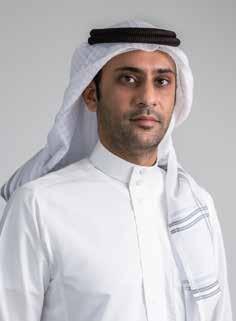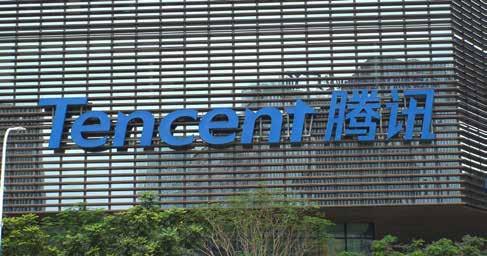
21 minute read
NEWS
PROVEN ARABIA LAUNCHES AI TECH START-UP
Proven Arabia has announced the launch of Proven Solution, a technology start-up that will offer a range of Artificial Intelligence (AI) apps powered through cutting-edge robotic products.
Advertisement
Proven Solution will provide advanced portfolio housing AI,
Robotics, Blockchain, Internet of
Things (IoT), Augmented Reality and
Virtual Reality (AR/VR) technologies.
These innovative products and solutions can be customised to fit business needs, enabling local and regional organisations to take full advantage of emerging applications and solutions.
Zaid Al Mashari, Group CEO of
Proven Arabia, said, “Businesses are driving the adoption of new technologies in the wake of the pandemic, resulting in a rapid
ORACLE ANNOUNCES AVAILABILITY OF JAVA 16

Oracle has announced the availability of Java 16 (Oracle JDK 16), including 17 new enhancements to the platform that will further improve developer productivity. The latest Java Development Kit (JDK) finalized Pattern Matching for instanceof (JEP 394) and Records pace of automation in the region. Building on this momentum, Proven Solution is founded on our vision of providing innovative applications and exceptional customer services that will help streamline business processes and drive efficiencies. We aim to offer advanced products that will play a vital role in the transformation of the tech and robotics industry.”
The company’s technology solution start-up will cement the success of innovative technologies in the GCC market and help spearhead revolutionary changes in the industry. The brand will also tap into the US and European markets, extending its expertise and solutions internationally. Proven Solution has already formed partnerships with several key industry leaders such as Softbank Robotics Europe, as service providers for their humanoid robots.
the Foreign-Memory Access API (JEP 389), and one preview feature, Sealed Classes (JEP 397).
Oracle delivers Java updates every six months to provide developers with a predictable release schedule. This offers a steady stream of innovations while also delivering continued performance, stability and security improvements, increasing Java’s pervasiveness across organisations and industries of all sizes.
“The power of the six-month release cadence was on full display with the latest release,” Georges Saab, VicePresident of development, Java Platform Group, Oracle. “Pattern Matching and Records were introduced a year ago as part of JDK 14 and have since gone through multiple rounds of community feedback based on realworld applications. This process has not only given Java developers the opportunity to experiment with these features before they were finalised, but also incorporated that critical feedback which has resulted in two rock-solid JEPs that truly meet the needs of the community.”
(JEP 395), language enhancements that were first previewed in Java 14. Additionally, developers can use the new Packaging Tool (JEP 392) to ship self-contained Java applications, as well as explore three incubating features, the Vector API (JEP 338), the Foreign Linker API(JEP 389), and
IFS LAUNCHES IFS CLOUD
IFS has launched IFS Cloud, a single platform that innately connects all its products to deliver the end-toend capabilities a company needs to orchestrate its customers, people and assets and deliver amazing Moments of Service, said the firm. Customers can choose to deploy best-of-breed or leverage the power of connecting their value chains across capabilities such as enterprise resource planning (ERP), customer relationship management (CRM), human capital management (HCM), asset management (EAM) and field service (FSM).
Darren Roos, IFS CEO, said, “The path to digital transformation is not a simple one. Most businesses are complex and have intricate value chains, which is why few organizations succeed and even fewer vendors provide the tools to truly enable it. At IFS, our single most important goal is to deliver value to our customers, and we want to provide a clear path for them to evolve to new business models, compete and win.”
With IFS Cloud, the company offers a unique and single technology platform with one common user experience, one data model and one consistent support offering. IFS Cloud brings simplicity, choice and innovation to organisations that need to evolve to new business models, control costs, expand faster and serve their customers better.
SANS Institute has announced its upcoming live online training program ‘SANS Riyadh March 2021’, to be held from the 21st of March to 1st of April. The program is designed to give professionals flexible access to indepth and practical courses online. It offers courses on security essentials, cloud security, incident handling, web applications security, and advanced network forensics CISSP Certification GISP.
According to IDC’s annual Saudi Arabia CIO Survey 2020, 25% of enterprises in Saudi Arabia plan to deploy on-premises, dedicated private clouds, multiple public clouds and legacy platforms to meet their infrastructure needs. However, security concerns form one of the three main obstacles towards cloud adoption.
Ned Baltagi, Managing Director, Middle East and Africa at SANS Institute, said, “The Gulf region, including Saudi Arabia, has been significantly exposed to geopolitical threat actors. In the current post-pandemic era, with looming lockdowns, closed borders, and remotely dispersed workforces, adopting cloud platforms is the way forward for enterprises. With SANS Riyadh March 2021, we continue to place emphasis on building skills to manage security practices in the cloud, as well as offer web application security.”

SANS INSTITUTE TO OFFER ONLINE TRAINING PROGRAMME FOR SAUDI

HUB71 LAUNCHES NEW VALUE CREATION PROGRAM

Hub71, Abu Dhabi’s global tech ecosystem, is doubling down on scaling startups and enabling founders by introducing a value creation program.
Tech startups from around the world will benefit from increased access to market as Hub71 actively facilitates business opportunities to enable their
Infor has announced Zahid Tractor, a Saudi Arabia-based Zahid Group company that supplies construction machinery and commercial vehicles, is now using Infor enterprise resource planning (ERP) to streamline and gain visibility across all departments. The integration of Infor M3 for Equipment allows Zahid Tractor to continue to distinguish its customercentric offering and commitment to excellence across the Kingdom of Saudi Arabia’s construction, transportation and rental sectors. Zahid Tractor originally depended on a bespoke homegrown enterprise information technology solution. As the company continued to grow, this sustainable growth, globally.
Hub71 launches its program by embarking on a four-month roadshow across the emirate to create opportunities for collaboration with leading Abu Dhabi corporates, particularly assets under Mubadala Investment Company and ADQ’s portfolio, as well as local and federal
solution was no longer feasible and could not support Zahid Tractor’s aggressive digital transformation drive. With the ambition of streamlining all facets of the business as part of its “Ethos of Excellence” and deploying state-of-the-art technologies (such as business intelligence, artificial intelligence and machine learning), Zahid Tractor commissioned one of the government agencies that govern and regulate national priority sectors and industries. The roadshow aims at strengthening Abu Dhabi’s innovation cluster and reinforcing Hub71’s intention to partner with like-minded organisations that share its mission to accelerate the emirate’s digital transformation.
Building on Hub71’s Corporate Engagement program, the global tech ecosystem is launching a new annual partners challenge, “The Outliers”, supported by leading entities in the public and private sectors to search for the boldest ideas to solve real challenges. This will foster new opportunities for startups worldwide to work alongside and support Abu Dhabi’s leading corporations and government agencies across various sectors, solving industry challenges with innovative new concepts. The initiative aims to build a solid pipeline of high-quality startups to consider doing business and relocating to Abu Dhabi.
big four consulting firms to oversee the due diligence process in selecting the ideal ERP solution. Upon completion of the due diligence process, Infor M3 for Equipment (manufacturing, distribution, equipment dealership and rental ERP solutions) was selected as the ideal solution in achieving Zahid Tractor’s ambitious digitalization aspirations.
ZAHID TRACTOR TURNS TO INFOR FOR DIGITAL TRANSFORMATION

3M TO INVEST $1 BILLION TO ACHIEVE CARBON NEUTRALITY

3M has announced it expects to invest approximately $1 billion over the next 20 years to accelerate new environmental goals: achieve carbon neutrality by 2050, reduce water use by 25% at its facilities, and return higher quality water to the environment after use in manufacturing operations.
“As we grow 3M, we will lead in
IBM has announced that its hybrid cloud services are now generally available in any environment – on any cloud, on premises or at the edge – via IBM Cloud Satellite. Lumen Technologies and IBM have integrated IBM Cloud Satellite with the Lumen edge platform to enable clients to harness hybrid cloud services in near real-time and build innovative solutions at the edge.
IBM Cloud Satellite brings a secured, unifying layer of cloud services for clients across environments, regardless of where their data resides. This is essential to help environmental stewardship, social equity and justice, and corporate governance,” said 3M chairman and CEO Mike Roman. “We are taking action now to bend the curve on carbon emissions and water use and improve water quality. Our investments will make us more effective and efficient and drive growth. Today’s announcements demonstrate again how 3M applies science to improve lives to
address critical data privacy and data sovereignty requirements. Industries including telecommunications, financial services, healthcare and government can now benefit from reduced latency that comes with analyzing data securely at the edge. Workloads related to online learning, remote work, telehealth services and more can now be delivered with increased efficiency and security with IBM Cloud Satellite. As workloads shift to the edge, IBM Cloud Satellite will help clients deliver low latency, while still enabling them to have the same levels of security, data privacy, interoperability and open standards found in hybrid cloud environments.
IBM is also extending Watson Anywhere with the availability of IBM Cloud Pak for Data as a Service with IBM Cloud Satellite. This gives clients a flexible, secure way to run their AI and analytics workloads as services help shape the world through cleaner air, better water quality, and less waste.”
The company’s long-term investments will help advance waste reduction and pollution control programs, reduce water usage, and acquire and apply best available technology. The investments further accelerate 3M’s continuous improvement of its manufacturing operations and ability to deliver on its environmental goals.
“We start 2021 with a firm assertation to implement practices that addresses the global environmental challenges facing our world today. At 3M, we are building a solid foundation and further embedding ESG into the core of our business operations to drive growth that is truly sustainable. We understand our obligation to the environment, and we are one step closer to achieving the goal we set ourselves of carbon neutrality,” said Robert Nichols, Managing Director Middle East and Africa, 3M
across any environment – without having to manage them on their own. EquBot, a fintech firm helping global investment professionals, is already seeing early benefits. The work has shown reduced latency from ten seconds to under one second on some of the time critical models. This allows investors to make better-informed decisions across financial markets.
IBM CLOUD SATELLITE TO HELP DELIVER CLOUD SECURELY

VMWARE EXPANDS REGIONAL HQ IN DUBAI
HE Saeed Mohammed Al Tayer, MD & CEO of Dubai Electricity and Water Authority (DEWA), has inaugurated the newly expanded regional HQ of VMware
Middle East, highlighting the role of digital technologies in developing innovative services in the UAE and the entire region.
“Moro Hub, a subsidiary of Digital
DEWA, the digital arm of Dubai
Electricity and Water Authority (DEWA), works to achieve the vision and the directives of HH Sheikh
Mohammed bin Rashid Al Maktoum,
Vice President and Prime Minister of the UAE and Ruler of Dubai, aiming at strengthening the leading position of the UAE and Dubai in the digital and smart solutions sector in the world.
As a leading data hub, our key goal is to build strategic partnerships with multinational technology providers like VMware,” said HE Saeed Mohammed Al Tayer.
“The newly expanded regional VMware HQ in Dubai comes as a result of this partnership, and reflects our keenness to streamline access to data, championing digital transformation, diversified economic growth, and embracing innovation agendas in alignment with Dubai 10X initiative and UAE Centennial 2071 that aims to make the UAE a global hub of advanced digital solutions. Today, partnerships among organizations sharing common goals are more important than ever, as they play a crucial role in supporting digital transformation at the organisational and national levels,” Al Tayer added
Since opening its first regional office in Dubai in 2012, VMware has developed its Middle East operation from an entity with 26 employees to a regional hub with 480 staff committed to helping organisations in the UAE and beyond achieve their transformation goals by enabling unprecedented flexibility in how they build and evolve their digital environments and serve customers.

TENCENT CLOUD DEPLOYS INTERNET DATA CENTRE HUB IN BAHRAIN

Tencent Cloud has announced its collaboration with the Bahrain Economic Development Board (EDB) – the Kingdom of Bahrain’s Investment promotion agency. The two parties signed a Memorandum of Understanding (MoU), with the aim to drive the Kingdom of Bahrain’s Internet Data Centre (IDC) development and support its rapid emergence as the Middle East and North Africa (MENA) region’s hub for the cloud and IDC sectors. The MoU signing also marks a significant milestone for Tencent Cloud as it deploys its first public cloud infrastructure in the MENA region.
H.E. Khalid Humaidan, Chief Executive, Bahrain Economic Development Board, said, “As a global leader in technology, innovation and cloud services, the EDB is very proud to be partnering with Tencent to set up their first MENA data center hub in Bahrain. We are confident that Tencent will be able to leverage on the Kingdom’s regional connectivity, local talent, and business friendly environment to expand their services and reach clients across the region.”
According to research by MarketsandMarkets, the Middle East’s cloud market is expected to reach $4.5 billion by 2024, with a CAGR of 17.5 percent over the same period, highlighting the growing opportunity in this region.
The MoU between Tencent Cloud and the Bahrain EDB will allow for substantial opportunities to boost the local digital economy, empowering local organisations to expedite their digital transformation journey. It will also allow Tencent Cloud to leverage on Bahrain’s regional position, and the EDB’s connectivity with local and regional stakeholders, including Bahrain’s sovereign wealth fund, Mumtalakat.




THE RISE OF FULL-STACK OBSERVABILITY
APPDYNAMICS, A PART OF CISCO, HAS RECENTLY RELEASED A STUDY THAT EXPLORES THE IMPACT OF THE RAPID ACCELERATION OF DIGITAL TRANSFORMATION, CREATED IN RESPONSE TO THE COVID-19 PANDEMIC, AND THE REPERCUSSIONS FOR GLOBAL TECHNOLOGISTS. NICK BOGATY, CHIEF REVENUE AND CUSTOMER OFFICER AT APPDYNAMICS, DISCUSSES THE DRAMATIC INCREASE IN IT COMPLEXITY CAUSED BY THE NEED FOR URGENT INNOVATION AND TELLS US WHY THERE IS AN UNPRECEDENTED DEMAND FOR FULL-STACK OBSERVABILITY WITH BUSINESS CONTEXT.
Can you share with us the key findings of the Agents of Transformation research?
In February, we released ‘Agents of Transformation 2021: The Rise of FullStack Observability’. The report comes at a time when many organisations are reflecting on a year of unremitting fire-fighting following the initial shock of COVID-19. In response to the pandemic, technologists across the world delivered incredible achievements - under immense pressure, as they pivoted their organization’s IT strategy. The report found that technologists implemented digital transformation projects faster in 2020 than in any previous year - on average, three times faster.
This is pretty incredible. But as a consequence, technologists are now struggling to manage crippling IT complexity caused by the rapid digital transformation and technologies required to support this change. 83% of technologists told us that their own job had become more complex over the last year.
To get a handle on this spiralling complexity, 95% of technologists overwhelmingly agreed that having real-time visibility across the entire IT estate is important. More specifically,

we found a clear and pressing need among IT teams to implement fullstack observability solutions to solve these challenges.
IT has always been complex, but what is making it worse now?
For some years now, consumer appetite for digital services has been increasing. Brands have had to adapt to deliver tailored, intuitive customer experiences across all digital channels, at all times. And this has led to a progressive increase in complexity across the IT environment. Many businesses have redefined their priorities, placing digital at the heart of their customer experience strategies.
The pandemic has accelerated this change. Enterprises shifted to digitalonly propositions and remote working almost overnight, and complex IT project rollouts were delivered in weeks rather than months or years. Many technologists fast-tracked the move towards cloud computing in order to respond quickly to the changing needs of their organisation. This gave them flexibility and the ability to spin services up and down. But they now face the challenge of managing IT systems both within and outside of the core IT estate and the complexity that comes with it.
Furthermore, the sheer amount of data that IT professionals are monitoring from all these services is staggering. We’re at the point where customers are overwhelmed and cannot cut through the noise, with huge numbers of technologists (75%) struggling to manage ‘data noise’ without the resources and support they need.
Why do we see the move to fullstack observability versus traditional monitoring?
Monitoring individual elements of the IT stack - applications, databases, servers, etc. - is critical, but for modern, digitallyfocused organisations, the stakes just got much higher and monitoring alone just isn’t enough anymore. Technologists now require complete and real-time visibility across the entire IT estate and the ability to monitor and correlate data across the stack. To achieve this, they need full-stack observability.
Full-stack observability is a hot topic right now. Why is that? A buzzword or mainstream technology?
The Agents of Transformation report showed that technologists are overwhelmingly keen to embrace full-stack observability, and they understand the benefits. But it also exposed a level of confusion and uncertainty among technologists with regard to the types of monitoring and observability solutions that are now available to them - 65% say it is difficult to distinguish between monitoring and observability tools.
There is clearly a need for greater transparency and clarity around full-stack observability within the market. AppDynamics is committed to providing technologists with the information and support they need to make informed decisions about their full-stack observability strategy.
The research revealed that 73% of technologists believe that the inability to connect fullstack observability with business outcomes will be detrimental to their business in 2021. Enterprise organisations have to act now, and while visibility across the entire IT stack might seem like the answer, it will only succeed when technologists can connect IT performance to business impact.
What key areas of the IT stack do technologists want to monitor?
Technologists require complete and real-time visibility across the entire IT estate, from traditional IT systems to new, hybrid cloud environments. In my conversations with customers, they talk about wanting to ‘connect the dots’ up and down the stack. This goes from the customer or employee-facing application all the way down to the lowest level infrastructure (compute, storage, network and public internet). They need a platform which is capable of receiving data from multiple sources to accurately understand and represent topologies and dependencies, and to drive actions.
Who should be driving digital customer experience? Is it the CIO, CMO, or someone else in the C-suite?
In a high functioning digital organisation, the IT department is in partnership with the business. We all know that IT used to be relegated as a back-office function, and now they are literally building the business. We started Agents of Transformation specifically because we could see individuals within our customers who were leading business transformation and digital customer experience within their organisation and putting technology at the center. We wanted to champion these people.
Full-stack observability with business context is about giving IT leaders the information they need to focus on what matters most to the business.
How do you connect full-stack observability with business performance?
IT teams need a single platform that enables them to monitor the full IT stack and quickly navigate through the data deluge to pinpoint the most critical data and contextualize IT performance insights with real-time business data. They need to observe what matters most by quickly understanding how it impacts the business, this means identifying the impact on tangible business outcomes such as customer experience, sales transactions and revenue. This will help them to prioritise actions, innovations and investments based on the direct impact to customers and the business.
Monitoring the internal IT environment is relatively easy. Is it challenging to keep track of what is outside of a company’s own environment?
The data that is within a company’s environment has traditionally been monitored by agents that you deploy
and have control over. Now - for all the reasons we’ve discussed - there is a technology sprawl across onpremise and cloud architectures and it is harder to monitor the technology you don’t directly control, such as the public internet and cloud. The Agents of Transformation data backs this up - 77% of technologists said that acceleration to cloud computing had been a contributing factor to increased technology complexity in 2020.
What are the barriers to the adoption of full-stack observability platforms?
Willingness and desire to embrace this technology among IT teams isn’t an issue. 96% of technologists recognise that having the ability to monitor all technical areas across their IT stack and directly link technical performance to business outcomes will be important during 2021, and 75% want to do this within the next 12 months.
But there are still barriers to overcome. Most common issues include a lack of skills within their IT department, developing a robust business case for investment, and potential integration issues. And our research also exposed a level of confusion and uncertainty among technologists with regard to the types of monitoring and observability solutions that are now available to them.
At AppDynamics, we guide our customers to determine which applications to start with and what types of business transactions should be monitored. We do a lot of consulting and get our customers up to speed. Many products out there allow you to collect data and correlate it in many different ways, but they don’t offer out-of-the-box insights correlation, and from what our Agents of Transformation have told us, that is critical to their business.
Do you leverage AI and ML to automate the process of finding issues and fixing them before it impacts business performance?
AI, machine learning and automation are built into our products. These technologies offer our customers the opportunity to fix digital problems before they even happen.
The Agents of Transformations report shows that technologists are under enormous pressure and being asked to perform new tasks. Can they rise to meet these challenges?
The pressure on the CIO - and the wider IT team - is very real. In 2020 technologists achieved incredible feats as they responded to the challenges posed by the pandemic. But the speed of innovation and change isn’t going to end. It’s only going to get more intense. Our data shows that 88% of technologists predict that the biggest challenge they will face in 2021 will be the need to drive through transformation at speed.
Enterprise organisations need elite technologists with the skills, vision and commitment to drive positive and sustainable digital transformation within their organisations to meet these challenges. At the same time technologists need specific resources and support from their organisations if they are to step up and operate at the highest level.
Do you think the role of IT is more important now than ever before?
Absolutely. This is a career-defining moment for technologists. They are in a position to step up and deliver the transformation their organizations need to compete and thrive in a turbulent and highly uncertain market.
What sets you apart from the competition?
AppDynamics is on a mission to help companies see their technology through the lens of the business so they can work together to prioritize what matters most. As a part of Cisco, AppDynamics is uniquely positioned to leverage the breadth of Cisco’s domain expertise in network, application, infrastructure and security - while also providing the business context they are known for.
We’re delivering full-stack observability that helps customers see, understand, and optimise what happens inside and beyond their architecture - all through the lens of business impact. The AppDynamics Business Observability platform will enable technologists to better prioritise and deliver the biggest impact for their business.










